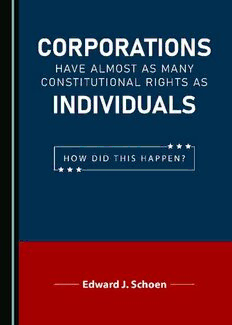
Corporations Have Almost as Many Constitutional Rights as Individuals: How Did This Happen? PDF
Preview Corporations Have Almost as Many Constitutional Rights as Individuals: How Did This Happen?
Corporations Have Almost as Many Constitutional Rights as Individuals : How Did This Happen? Corporations Have Almost as Many Constitutional Rights as Individuals : How Did This Happen? By Edward J. Schoen Corporations Have Almost as Many Constitutional Rights as Individuals: How Did This Happen? By Edward J. Schoen This book first published 2020 Cambridge Scholars Publishing Lady Stephenson Library, Newcastle upon Tyne, NE6 2PA, UK British Library Cataloguing in Publication Data A catalogue record for this book is available from the British Library Copyright © 2020 by Edward J. Schoen All rights for this book reserved. No part of this book may be reproduced, stored in a retrieval system, or transmitted, in any form or by any means, electronic, mechanical, photocopying, recording or otherwise, without the prior permission of the copyright owner. ISBN (10): 1-5275-4793-0 ISBN (13): 978-1-5275-4793-3 TABLE OF CONTENTS Introduction ................................................................................................ 1 Views of the Founders ................................................................................ 3 Debates over Chartering First and Second Banks of the United States ...... 6 Treatment of Corporations in Early U.S. Supreme Court Decisions (1809-1839) ................................................................................................ 9 (1) Corporations as Citizens for Purposes of Diversity Jurisdiction (2) Corporations as Citizens under the Privileges and Immunities Clause of Article IV (3) Corporations and the Contracts Clause (4) Lessons Learned from Early U.S. Supreme Court Decisions Ratification of the Fourteenth Amendment (1868) ................................... 25 U.S. Supreme Court Decisions (1868-1879) ............................................ 32 (1) Paul v. Virginia (1868) (2) Tomlinson v. Jessup (1872) (3) Sinking Fund Cases (1878) (4) Stone v. Mississippi (1879) Populists, Progressives and the U.S. Supreme Court ................................ 41 The Railroad Tax Cases and County of Santa Clara v. Southern Pac. R. Co. ................................................................................................ 44 The Railroad Tax Cases (Cir. Ct. 1882) County of Santa Clara v. Southern Pacific Railroad Company (Cir. Ct. 1883) County of Santa Clara v. Southern Pacific Railroad Company (U.S. Supreme Court 1886) Fire Association of Philadelphia v. New York (1886) Minneapolis & St. Louis Railway Company. v. Beckwith (1889) Home Insurance Company of New York v. State of New York (1890) vi Table of Contents The Lochner Era Begins ........................................................................... 55 Gulf, Colorado and Santa Fe Railway v. Ellis (1897) Allgeyer v. State of Louisiana (1897) Nobile v. Union River Logging Railroad Co. (1893) Chicago, Burlington and Quincy Railroad Co. v. City of Chicago (1897) Lochner v. State of New York (1905) Adair v. United States (1908) Armour Packing Co. v. United States (1908) Lochner Temporarily Fades ...................................................................... 68 Hale v. Henkel (1906) Northwestern National Life Insurance. Company. v. Riggs (1906) Western Turf Association v. Greenberg (1907) Selover, Bates & Co. v. Walsh (1912) Bunting v. Oregon (1917) Lochner’s Resuscitation ........................................................................... 76 Pennsylvania Coal Co. v. Mahon (1922) Adkins v. Children’s Hospital of the District of Colombia (1923) Quaker City Cab Co. v. Pennsylvania (1928) Economic Liberty and the New Deal ........................................................ 83 Railroad Retirement Act Bituminous Coal Conservation Act National Industrial Recovery Act Frazier-Lemke Act Agricultural Adjustment Act Minimum Wage Provisions of the New York Labor Law President Roosevelt Tries to Pack the U.S. Supreme Court ................... 100 Switch in Time That Saved the Nine. Not! ............................................ 103 The U. S. Supreme Court’s Counterattack on Lochner .......................... 108 Corporations’ Constitutional Rights in the Middle Decades (1944-1977) ............................................................................................ 111 Corporations Have Almost as Many Constitutional Rights as Individuals: vii How Did This Happen? Accumulating Fundamental Rights: 1978-2014 ..................................... 120 Citizens United: It’s a bit complicated. Burwell v. Hobby Lobby Stores, Inc. It’s a Little More Straightforward. Artificial Entities, Corporate Personhood, Constitutional Purpose, and Association of Citizens .................................................................... 148 Importance of Corporate Constitutional Rights Conclusion .............................................................................................. 158 INTRODUCTION Two recent decisions of the U.S. Supreme Court have substantially enlarged the scope of fundamental rights accorded corporations. In Citizens United v. F.E.C., the Court determined that Citizens United, a non-profit corporation, has a First Amendment right to spend unlimited amounts of money to broadcast “electioneering communications” supporting candidates for public office.1 In doing so, the Court described corporations as “associations of citizens” deserving fundamental rights just like living persons. The Court noted that “[p]olitical speech is indispensable to decision making in a democracy, and this is no less true because the speech comes from a corporation rather than an individual.”2 In Burwell v. Hobby Lobby Stores, Inc.,3 the U.S. Supreme Court decided that the United States Department of Health and Human Services’ (HHS) requirement that closely held corporations provide health-insurance coverage for methods of contraception, which were contrary to the genuine religious beliefs of the companies’ owners, violated the Religious Freedom Restoration Act of 1993 (RFRA).4 RFRA requires that strict scrutiny applies to any federal government action which substantially burdens the exercise of religion, i.e., the government action is illegal unless it is the least restrictive means of advancing a compelling government interest.5 In short order, corporations’ exercise of political and religious expression is deemed to be protected by the First Amendment, despite the fact corporations cannot vote or hold political office and possess neither human dignity nor a religious conscience. How this transformation of fundamental rights from individual freedoms to corporate entitlements has occurred is a fascinating story that shows how four dramatically different approaches - artificial entities, corporate personhood, constitutional purpose, and associations of persons - morphed over the past two hundred and twenty five years and paved the way to the constitutional enshrinement of corporations. 1 Citizens United v. F.E.C., 558 U.S. 310, 372 (2010). 2 Id. at 349. 3 Burwell v. Hobby Lobby Stores, Inc., 573 U.S. 682 (2014). 4 42 U.S.C. §§ 2000bb et seq. (2016). 5 Hobby Lobby, 573 U.S. at 690-91.
